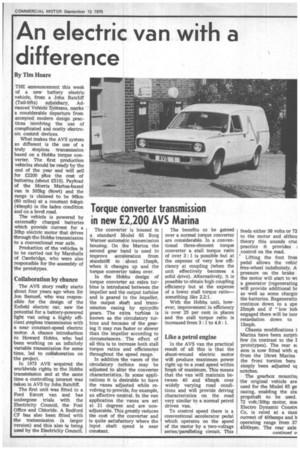An electric van with a difference
Page 35

If you've noticed an error in this article please click here to report it so we can fix it.
By Tim Hoare
THE announcement this week of a new battery electric vehicle, from a John Ratcliff (Tai(l-lifts) subsidiary, Advanced Vehicle Systems, marks a considerable departure from accepted modern design practices involving the use of complicated and costly electronic conk:mil devices.
What makes the AVS system so different is the use of a truly stepless transmission based on a Hobbs torque converter. The first production vehieles should be ready by the end of the year and will sell for £2200 plus the cost of batteries (albout £510). Payload 'of the Morris Marina-based van is 305kg (60wit) and the range is claimed to be 961an (60 Miles) at a constant 64kph (40mph) in the laden condition and on a level road.
The vehicle is powered by externally charged batteries which provide current for a 30hp electric motor that drives through the Hobbs transmission to a conventional rear 'axle.
Production of the vehicles is to be carried out by Marshalls of Cambridge, who were also responsible for the assembly of the prototypes.
Collaboration by chance
The -AVS Story really starts about four years ago when Sir Jon Samuel, who was responsible for the design of the Enfield electric oar, saw the potential for a battery-powered light van using a highly efficient stepless transmission With a near constant-speed electric motor. A Chance introduction to Howard 'Hobbs, who had been working on an infinitely Variable transmission for some time, led to collaboration on the project.
In 1973 AVS 'acquired the worldwide rights to the Hobbs transmission and at the same time a contrelling interest was taken in AVS by John Rateliff.
The first unit was fitted to a Ford Escort van and has undergone trials with the Electricity Council, the Post Office and Chloride. A Bedford CF has also been fitted with the transmission (a larger version) and this also is being used by the Electricity Council.
















































































































